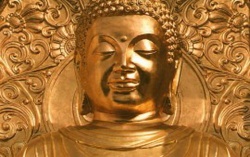Difference between revisions of "Four Seals"
(Redirected page to 4 Seals) |
|||
| (8 intermediate revisions by 3 users not shown) | |||
| Line 1: | Line 1: | ||
| − | # | + | [[File:Ddha-other.jpg|thumb|250px|]] |
| + | |||
| + | |||
| + | |||
| + | |||
| + | |||
| + | |||
| + | |||
| + | |||
| + | |||
| + | The '''[[four seals]]''' (Tib. {{BigTibetan|[[སྡོམ་བཞི་]]}}, [[Wyl.]] ''[[sdom bzhi]]'') or the 'four hallmarks of the [[Buddha]]'[[s]] teachings' (Tib. {{BigTibetan|[[ལྟ་བ་བཀའ་རྟགས་ཀྱི་ཕྱག་རྒྱ་བཞི་]]}}, [[Wyl.]] ''[[lta ba bka' rtags kyi phyag rgya bzhi]]''). They are: | ||
| + | |||
| + | {| class="wikitable" style="color:black;background-color:#f7f7e7;" cellspacing="5" border="0" text-align:left,top" | ||
| + | |+ | ||
| + | |valign="top"| | ||
| + | <poem> | ||
| + | [[Four Seals]] | ||
| + | They are: | ||
| + | |||
| + | All [[phenomena]] are [[impermanent]]. | ||
| + | All [[Dharma]] are [[not-self]]. | ||
| + | The {{Wiki|eternity}} is [[Nirvana]]. | ||
| + | All [[sensations]] are [[suffering]]. | ||
| + | </poem> | ||
| + | :All that is [[conditioned]] is [[impermanence|impermanent]],<br> | ||
| + | :All that is [[tainted]] is [[suffering]],<br> | ||
| + | :[[Nirvana]] is [[peace]],<br> | ||
| + | :All [[phenomena]] are [[empty]] and devoid of [[self]]. | ||
| + | |valign="top"| | ||
| + | ::<big>{{BigTibetan|[[༈ འདུ་བྱེད་ཐམས་ཅད་མི་རྟག་ཅིང༌།]]}} <br> | ||
| + | ::{{BigTibetan|[[ཟག་བཅས་ཐམས་ཅད་སྡུག་བསྔལ་བ།]]}} <br> | ||
| + | ::{{BigTibetan|[[ཆོས་རྣམས་སྟོང་ཞིང་བདག་མེད་པ།]]}} <br> | ||
| + | ::{{BigTibetan|[[མྱང་ངན་འདས་པ་ཞི་བའོ། །]]}}</big><br> | ||
| + | |} | ||
| + | ==Significance of the [[Four Seals]]== | ||
| + | These are said to be the hallmark of the [[Buddha’s teaching]], and it is often said that the mark of a {{Wiki|real}} [[Buddhist]] is that he or she accepts these four. Of course, taking [[refuge]] is the {{Wiki|real}} entrance to the [[Buddhist path]], and that which serves to distinguish [[Buddhists]] from non-buddhists, but in terms of the [[View]], these four statements encapsulate the [[uniqueness]] of the [[Buddha’s teachings]] and really set the [[Buddhadharma]] apart from all other [[religions]] and [[philosophies]]. | ||
| + | |||
| + | ==Sources== | ||
| + | |||
| + | |||
| + | Phillip Stanley has noted that the [[Four Seals]] do not appear in the early [[Tibetan]] sources on [[Buddhist]] {{Wiki|terminology}}, the ''[[Mahavyutpatti]]'', ''[[Madhyavyutpatti]]'', or [[Kawa Paltsek]]'[[s]] ''Memoranda on [[Dharmic]] Enumerations'' (''[[chos kyi rnam grangs kyi brjed byang]]''). According to his research, the first [[Tibetan]] author to mention the [[four seals]] was [[Longchen Rabjam]] in his ''[[Treasury of Philosophical Tenets]]''. The [[scholar]] [[Butön]] mentions [[three seals]], an {{Wiki|enumeration}} that is also to be found in [[Indian]] sources, such as [[Shakyaprabha]]'[[s]] ''[[Prabhāvatī]]'' (''<nowiki>'</nowiki>od ldan''). [[Tibetan]] sources do not <ref>From: D. Phillip Stanley,''The Threefold Formal, Practical, and Inclusive Canons of [[Tibetan Buddhism]] in the Context of a Pan-Asian {{Wiki|Paradigm}}'' (Doct.Diss.), {{Wiki|University of Virginia}}, 2009, pp. 149-154</ref> | ||
| + | |||
| + | {{reflist}} | ||
| + | |||
| + | {{RigpaWiki}} | ||
| + | {{NewSourceBreak}} | ||
| + | ;[[Four Seals]] | ||
| + | |||
| + | : 1. All produced [[phenomena]] are [[impermanent]] | ||
| + | : 2. All contaminated products are in the {{Wiki|nature}} of [[Suffering]] | ||
| + | : 3. All [[phenomena]] are [[Emptiness]] | ||
| + | : 4. [[Nirvana]] is [[peace]].: | ||
| + | |||
| + | ;[[Four Seals]] | ||
| + | |||
| + | They are: | ||
| + | |||
| + | : 1 All [[phenomena]] are [[impermanent]]. | ||
| + | : 2 All [[Dharma]] are {{Wiki|not-self}}. | ||
| + | : 3 The {{Wiki|eternity}} is [[Nirvana]]. | ||
| + | : 4 All [[sensations]] are [[suffering]]. | ||
| + | |||
| + | {{BuddhismbyNumber}} | ||
| + | [[Category:Buddha Seal's]]{{BuddhismbyNumber}} | ||
Latest revision as of 18:18, 17 April 2024
The four seals (Tib. སྡོམ་བཞི་, Wyl. sdom bzhi) or the 'four hallmarks of the Buddha's teachings' (Tib. ལྟ་བ་བཀའ་རྟགས་ཀྱི་ཕྱག་རྒྱ་བཞི་, Wyl. lta ba bka' rtags kyi phyag rgya bzhi). They are:
|
Four Seals
|
Significance of the Four Seals
These are said to be the hallmark of the Buddha’s teaching, and it is often said that the mark of a real Buddhist is that he or she accepts these four. Of course, taking refuge is the real entrance to the Buddhist path, and that which serves to distinguish Buddhists from non-buddhists, but in terms of the View, these four statements encapsulate the uniqueness of the Buddha’s teachings and really set the Buddhadharma apart from all other religions and philosophies.
Sources
Phillip Stanley has noted that the Four Seals do not appear in the early Tibetan sources on Buddhist terminology, the Mahavyutpatti, Madhyavyutpatti, or Kawa Paltsek's Memoranda on Dharmic Enumerations (chos kyi rnam grangs kyi brjed byang). According to his research, the first Tibetan author to mention the four seals was Longchen Rabjam in his Treasury of Philosophical Tenets. The scholar Butön mentions three seals, an enumeration that is also to be found in Indian sources, such as Shakyaprabha's Prabhāvatī ('od ldan). Tibetan sources do not [1]
Footnotes
- ↑ From: D. Phillip Stanley,The Threefold Formal, Practical, and Inclusive Canons of Tibetan Buddhism in the Context of a Pan-Asian Paradigm (Doct.Diss.), University of Virginia, 2009, pp. 149-154
Source
- 1. All produced phenomena are impermanent
- 2. All contaminated products are in the nature of Suffering
- 3. All phenomena are Emptiness
- 4. Nirvana is peace.:
They are:
- 1 All phenomena are impermanent.
- 2 All Dharma are not-self.
- 3 The eternity is Nirvana.
- 4 All sensations are suffering.
